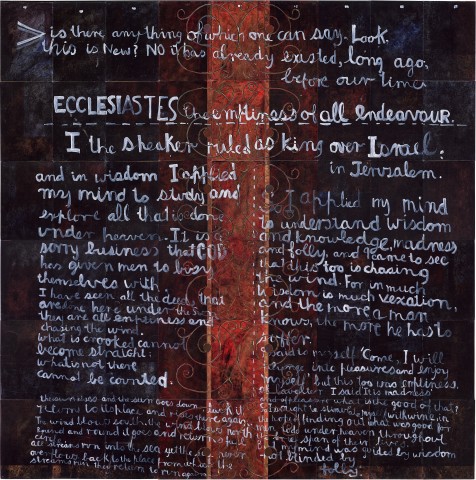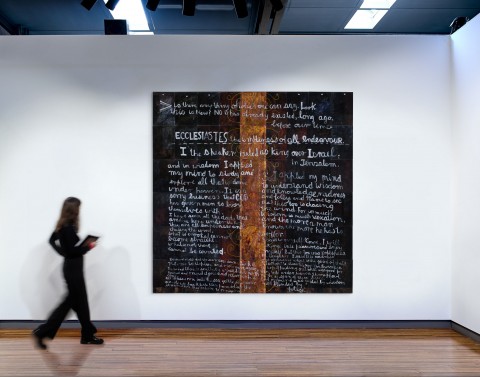ORNAMENTAL DESPAIR, 1989
IMANTS TILLERS
synthetic polymer paint and gouache on 54 canvas boards
227.0 x 229.0 cm (overall)
each panel numbered sequentially with stencil verso: 19918 - 19971
Deutscher Brunswick Street, Melbourne
Martin Browne Fine Art, Sydney
Private collection, Sydney
Imants Tillers: Poem of Ecstasy, Deutscher Brunswick Street, Melbourne, 28 February – 24 March 1990, cat. 4 (illus. exhibition catalogue)
Curnow, W., Imants Tillers and the ‘Book of Power’, Craftsman House, G+B Arts International, Sydney, 1998, pl. 12, pp. 37 (illus.), 161, 169
Over the last five decades, Imants Tillers has consistently investigated issues of cultural identity and displacement and concerns about origins and originality, rightly establishing his reputation as one of Australia’s foremost postmodern artists. Forging his international career in the 1970s and into the 80s, Tillers was included in the XIII Bienal de São Paulo, Brazil in 1975, in Documenta 7 in Kassel, Germany in 1982, and in exhibitions at PS1, New York and The Corcoran Gallery of Art, Washington DC (both 1984); culminating in his representation of Australia at the Venice Biennale in 1986, at the age of thirty-five.
At the heart of Tillers’ intriguing oeuvre is a conceptual, practical and material framework that he developed in the 1980s. Known as The Book of Power,1 this system sees the artist work on small canvas boards that are numbered, stacked and then hung in order in grids; their individual contents coming together in large-scale installations of complex imagery drawn from a variety of visual sources. While none of the appropriated imagery within an Imants Tillers painting is the artist’s ‘own’, his work remains immediately recognisable as ‘a Tillers’, with the found imagery within his work creating new possibilities and ideas through their careful juxtaposition. Importantly, Tillers’ transcription of the art of others is never exact – like the act of reproduction, it too is open to slippage and change. As curator Deborah Hart has noted, Tillers ‘… cherishes the fact that “the self”, like art and life itself, is continuously open to interpretation—mutable, never fully understandable and always in a state of becoming.’2
Iconic New Zealand artist Colin McCahon has long been a subject of interest (and use) for Tillers, and McCahon’s distinctive and instantly identifiable handwriting and quotation from the Book of Ecclesiastes fills the composition of Ornamental Despair, 1989.3 McCahon’s existential fascination with identity, faith and doubt, and the human condition clearly resonates with Tillers, just as the opening line from Ecclesiastes echoes his own conceptual practice and interest in the figure of the artist as a conduit for ideas: ‘There is a constant tension between the search for meaning, the desire for transcendence and a pervasive, immovable scepticism. It is this aspect of McCahon that I find most interesting and most relevant to our condition today.’4
True to form, however, this is not a conversation between Tillers and McCahon alone. Tillers interrupts McCahon’s incantation in Ornamental Despair with a brown column-like form, introducing both colour and light (and a possible source of revelation or redemption?) into McCahon’s previously monochromatic work. This totemic form is in turn overlaid by an almost whimsical play of architectural ornament, drawn from the work of American abstractionist Philip Taaffe.5 Taaffe, like Tillers, is known for his use of found imagery (in Taaffe’s case, found abstraction) and for his creative reinvention and reworking of the history of art. In this knowing combination of McCahon, Taaffe and Tillers in Ornamental Despair, images and intentions coalesce across time and space, coming together in new ways that reflect Tillers’ ongoing quest to investigate the complexities and potential meaning of our existence through his art.
1. The idea for the Book of Power was inspired by French poet Stéphane Mallarmé, whose free verse poem of 1897, Un coup de dés jamais n’abolira le hazard (A throw of the dice will never abolish chance), with its unusual typographic layout, is said to have anticipated concrete poetry.
2. Hart, D., Imants Tillers: One World Many Visions, National Gallery of Australia, Canberra, 2006, p. 3
3. This is drawn from McCahon’s painting Is there anything of which one can say look this is new?, 1982, Bank of New Zealand Collection, Colin McCahon Online Catalogue, see: https://www.mccahon.co.nz/cm001300
4. Curnow, W., Imants Tillers and the ‘Book of Power’, Craftsman House, Sydney, 1998, p. 146, cited in Hart, op. cit., p. 33
5. I am grateful to Mary Eagle for this connection. See Eagle, M., “Imants Tillers” in Imants Tillers: Poem of Ecstasy, Deutscher Brunswick Street, Melbourne, 1990, p. 5
KELLY GELLATLY

